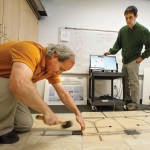 Over the past year or so I’ve written extensively about developments in healthcare for the elderly, especially in mobile and wearable technology.
Over the past year or so I’ve written extensively about developments in healthcare for the elderly, especially in mobile and wearable technology.
I’ve also written about the large number of telehealth innovations, such as Babylon and Vida, that are aiming to deliver a more responsive and user friendly care experience.
An example of how this can be effective was a recent trial at Airedale NHS trust, which installed a telehealth system in a care home for the elderly, thus providing residents with 24/7 care.
When the system was tested out, it saw a 35% reduction in emergency admissions and a 53% drop in A&E attendance.
With developments around these areas, and of course the Internet of Things tying it all together, it seems inevitable that there will be considerable advances in how our homes can be made more conducive and supportive to our health.
The Smart Care Home
An example of the kind of thing that could be on the horizon comes via a prototype developed by the University of Texas at Arlington. They’re releasing a model Smart Care apartment that comes complete with a host of technologies to reduce risks associated with old age, thus helping the elderly live a comfortable, and safe, life in their own homes.
The five year project was backed with $600,000 in funding and involved representation from the nursing and engineering teams at the university.
“UT Arlington is at the forefront of life-changing and innovative research in the area of Health and the Human Condition,” the university say. “Ultimately, Smart Care will positively impact senior citizens, people with disabilities, and injured veterans. It will also save money for people across the Dallas-Fort Worth area and nationwide by reducing the number of repeated trips to hospitals for some residents.”
With most western countries experiencing a booming elderly population, innovations such as this could be crucial to the continuation of healthcare provision at an affordable price.
The Smart Care homes will come with a number of interesting technologies, including:
- Sensors underneath tiles on the floor that will allow researchers to measure and evaluate changes in walking gaits and weight that might suggest illness or injury;
- A special camera embedded in a bathroom mirror that will tell researchers about day-to-day heart rate, facial expression, and skin color. Changes in expression and skin color can reveal aspects of the overall health status as well as about oxygen content of the blood;
- Lift chair to help residents stand;
- Smart appliances such as an LG microwave, range and refrigerator;
- Connected exercise equipment, including a recumbent bike and interactive Kinect-based Tai Chi trainer;
- Other systems that will detect whether medication is being properly managed or if the resident is not sleeping well or staying in bed too long.
Data from the home is fed into a mission control style lab where patients can be monitored, have their behavioral information interpreted and their remote capabilities evaluated.
“Ultimately, the goal is to have these technologies in homes so that people could have warning signs if something is changing; you could also detect if something has already happened and there is a need to call for help,” the university say. “Again, the hope is that people can stay home much longer than they can currently.”
Great post ! And Awesome ideas to make your home more smart then now.your video for home appliances is innovative and useful for us.
Yup it is true. When your surroundings are +ive and healthy then your whole day goes very smoothly and happily so make your home smarter.